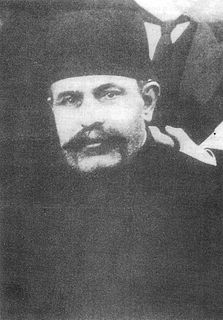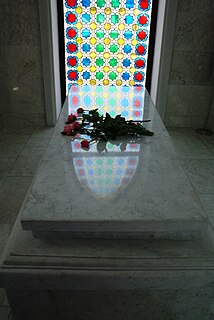 W
WThe Qajar dynasty was an Iranian royal dynasty of Turkic origin, specifically from the Qajar tribe, ruling over Iran from 1789 to 1925. The Qajar family took full control of Iran in 1794, deposing Lotf 'Ali Khan, the last Shah of the Zand dynasty, and re-asserted Iranian sovereignty over large parts of the Caucasus. In 1796, Mohammad Khan Qajar seized Mashhad with ease, putting an end to the Afsharid dynasty, and Mohammad Khan was formally crowned as Shah after his punitive campaign against Iran's Georgian subjects. In the Caucasus, the Qajar dynasty permanently lost many of Iran's integral areas to the Russians over the course of the 19th century, comprising modern-day Georgia, Dagestan, Azerbaijan and Armenia.
 W
WQajar art refers to the art, architecture, and art-forms of the Qajar dynasty of the late Persian Empire, which lasted from 1781 to 1925 in Iran (Persia).
 W
WAbbas Mirza Mosque was a nineteenth-century Shia mosque in Yerevan, Armenia. Abbas Mirza the eighteenth century, the castle was built by the mosque in Yerevan. This mosque was built at the beginning of the nineteenth century, during the reign of the last khan (governor) of the Erivan Khanate, Huseyn Khan. It was named Abbas Mirza Jami, after the Persian crown prince Abbas Mirza, the son of Fat′h-Ali Shah. The façade of mosque was covered in green and blue glass, reflecting Persian architectural styles. After the capture of Yerevan by the Russians, the mosque was used as an arsenal. The mosque was turned into barracks after it was conquered by Russian troops.
 W
WAbbasabad was a fortress of strategic importance for the defense of the Nakhichevan khanate.
 W
WFereydun Adamiyat or Fereidoon Adamiyat was a leading social historian of contemporary Iran and particularly the Qajar era. He was the son of Abbasquli Adamiyat, a pioneer of the Iranian Constitutional Revolution. Fereydun Adamiyat received his B.A. from the University of Tehran and his PhD in diplomatic history from the London School of Economics. He is known for his original works on various aspects of the social and political history of Persia, most of them dealing with the ideological foundations of the Iranian Constitutional Revolution. Believing firmly in history's "Rational Movement", Adamiyat saw no conflict between normative judgement and claims to objectivity. Although predominantly published in Persian, he is often cited by Western scholars. His most famous book was Amir Kabir and Iran.
 W
WSir Sultan Mahomed Shah, Aga Khan III was the 48th Imam of the Nizari Ismaili religion. He was one of the founders and the first permanent president of the All-India Muslim League (AIML). His goal was the advancement of Muslim agendas and protection of Muslim rights in India. The League, until the late 1930s, was not a large organisation but represented the landed and commercial Muslim interests of the British-ruled 'United Provinces'. He shared Sir Syed Ahmad Khan's belief that Muslims should first build up their social capital through advanced education before engaging in politics. Aga Khan called on the British Raj to consider Muslims to be a separate nation within India, the so-called 'Two Nation Theory'. Even after he resigned as president of the AIML in 1912, he still exerted major influence on its policies and agendas. He was nominated to represent India to the League of Nations in 1932 and served as President of the League of Nations from 1937–38.
 W
WPrince Shāh Karim al-Husayni, known by the religious title Mawlana Hazar Imam within Ismaili Muslim circles and as Aga Khan IV elsewhere, is the 49th and current Imam of Nizari Ismailism, a denomination of Isma'ilism within Shia Islam. He has held this position of imam since 11 July 1957, when, at the age of 20, he succeeded his grandfather, Sir Sultan Muhammad Shah Aga Khan III. Aga Khan claims to be a direct lineal descendant of the Islamic prophet Muhammad through Muhammad's cousin and son-in-law, Ali, considered the first Imam in Shia Islam, and Ali's wife Fatima az-Zahra, Muhammad's daughter from his first marriage.
 W
WAga Khan II, or Aqa Ali Shah, the 47th Imam of the Nizari Ismaili Muslims. A member of the Iranian royal family, he became the Imam in 1881. During his lifetime, he helped to better not only his own community, but also the larger Muslim community of India. He was an avid sportsman and hunter. He was the second Nizari Iman to hold the title Aga Khan.
 W
WPrince Sadruddin Aga Khan, KBE, KCSS was a statesman and activist who served as United Nations High Commissioner for Refugees from 1966 to 1977, during which he reoriented the agency's focus beyond Europe and prepared it for an explosion of complex refugee issues. He was also a proponent of greater collaboration between non-governmental organizations (NGOs) and UN agencies. The Prince's interest in ecological issues led him to establish the Bellerive Foundation in the late 1970s, and he was a knowledgeable and respected collector of Islamic art.
 W
WPrincess Yasmin Aga Khan is a Swiss-born American philanthropist known for raising public awareness of Alzheimer's disease.
 W
WAhmad Moshir al-Saltaneh, also known Moshir al-Saltaneh and Mirza Ahmad Khan Moshir al-Saltaneh was a Prime Minister of Qajar era Iran. He served as Prime Minister of Iran twice and served as minister of interior.He was also Iran's Justice minister.
 W
WFathollah Khan Akbar was an Iranian Prime Minister. He was Minister of Justice in several Iranian Cabinets. He was a representative of Iranian Parliament from Ahwaz. He is the 17th Prime Minister of Iran serving from October 1920 to February 1921 when he was deposed by a Coup by Seyyed Zia'eddin Tabatabaee and Reza Khan.
 W
WPrince Ali Salman Aga Khan, known as Aly Khan, was a son of Sultan Mahommed Shah, Aga Khan III, the leader of the Nizārī Ismaili Muslims, a sect of Shia Islam, the father of Aga Khan IV and a sayyid descendant of Muhammad through his cousin Ali, daughter Fatimah and grandson Husayn ibn Ali.
 W
WBahman Mirza Qajar Mausoleum — is a mausoleum with 3 domes located 25 meters north-east from Imamzadeh architectural complex in Barda.
 W
WThe Bahmani family, also Bahmani-Qajar is an aristocratic Persian family belonging to one of the princely families of the Qajar dynasty, the ruling house that reigned Iran 1785–1925. The founder is Bahman Mirza Qajar (1810–1884), younger brother of Mohammad Shah Qajar and formerly prince regent and governor of Azerbaijan 1841–1848.
 W
WNizami Bahmanov was an Azerbaijani politician who served as the Head of the Executive Power of Shusha and the Chairman of the Azerbaijani Community of Nagorno-Karabakh in Exile.
 W
WGholām-Hossein Banān was an Iranian musician and singer. One of the most prominent Iranian singers of the 20th century, he was renowned for the quality of his voice.
 W
WEmarateh Amiriyeh is an old building dating from the Qajar period. It is located on Saheli street, Persian Gulf park, Kooti district, Bushehr, Iran. It was listed as National works of Iran with record number 2319 on 9 May 1999.
 W
WErivan Fortress was a 16th-century fortress in Yerevan.
 W
WFath Ali shah inscription is located in Cheshmeh-Ali in Rey, Iran. This work is one of several inscriptions made in the Fath Ali Shah era, located on Cheshmeh-Ali hill. Fath Ali shah inscription is spot in north of Rey near Cheshmeh-Ali park and beneath the Rey Castle.
 W
WThe Ganja Khanate was a semi-independent Caucasian khanate that was established in Afsharid Iran and existed in the territory of what is modern-day Azerbaijan between 1747-1805. The principality was ruled by the dynasty of Ziyadoglu (Ziyadkhanov) of Qajar extraction as governors under the Safavids and Nadir Shah. Shahverdi Solṭan Ziyad-oglu Qajar became the khan of Ganja in 1554.
 W
WMargarita Carmen Hayworth was an American actress and dancer. She achieved fame during the 1940s as one of the era's top stars, appearing in 61 films over 37 years. The press coined the term "The Love Goddess" to describe Hayworth after she had become the most glamorous screen idol of the 1940s. She was the top pin-up girl for GIs during World War II.
 W
WIrandokht was the first child of Ahmad Shah Qajar and Badr al-Molouk. She was princess of Iran and the heir presumptive to the Crown of Iran before leaving the country with her parents when she was 5 years old.
 W
WIranian Armenia (1502–1828) refers to the period of Eastern Armenia during the early-modern and late-modern era when it was part of the Iranian empire. Armenians have a history of being divided since the time of the Byzantine Empire and the Sassanid Empire, in the early 5th century. While the two sides of Armenia were sometimes reunited, this became a permanent aspect of the Armenian people. Following the Arab and Seljuk conquests of Armenia, the western portion, which was initially part of Byzantium, became eventually part of the Ottoman Empire, otherwise known as Ottoman Armenia, while the eastern portion became and was kept part of the Iranian Safavid Empire, Afsharid Empire and Qajar Empire, until it became part of the Russian Empire in the course of the 19th century, following the Treaty of Turkmenchay of 1828.
 W
WMalekeh-Jahan was the queen consort and cousin of Mohammad Ali Shah, and a member of the Qajar dynasty. Jahan is the daughter of Prince Kamran Mirza Nayeb es-Saltaneh and mother of Ahmad Shah Qajar. When she became queen, she naturally was called Queen Jahan. However, Queen Jahan also can be interpreted as Malekeh-ye Jahan or "Queen of the World."
 W
WPierre Amédée Emilien Probe Jaubert was a French diplomat, academic, orientalist, translator, politician, and traveler. He was Napoleon's "favourite orientalist adviser and dragoman".
 W
WAghabeyim agha Javanshir was an Azerbaijani poet, daughter of the second khan of Karabakh Ibrahim Khalil khan, a wife of Iranian shah Fath-Ali Shah Qajar, and aunt of poet Khurshidbanu Natavan. She wrote under the alias Aghabaji.
 W
WJean-Baptiste Feuvrier was a French military physician, who, from August 1889 to October 1892, served as the personal physician to Naser al-Din Shah Qajar, King (Shah) of Qajar Iran. He wrote a travelogue about his life in Iran, the Trois ans à la cour de Perse. Prior to his appointment in Iran, he served as a personal physician to Prince Nicholas of Montenegro.
 W
WPrince Amyn Muhammad Aga Khan is the younger brother of Aga Khan IV, Imam of the Nizari Isma'ili sect of Shia Islam. He is the son of Prince Aly Khan and Princess Tajuddawlah Aga Khan.
 W
WJafar al-Javad Khan Ziyad oghlu Qajar was a member of the Qajar dynasty, and the last khan of the Ganja khanate from 1786 to 1804.
 W
WThe khanates of the Caucasus, or Azerbaijani khanates or Persian khanates, or Iranian khanates, were various provinces and principalities established by Persia (Iran) on their territories in the Caucasus from the late Safavid to the Qajar dynasty. The Khanates were mostly ruled by Khans of Turkic (Azeri) origin and were vassals and subjects of the Iranian shah (King). Persia permanently lost a part of these khanates to Russia as a result of the Russo-Persian Wars in the course of the 19th century, while the others were absorbed into Persia.
 W
WMir-Fatah-Agha, commonly known as Mushthaid, was a high-ranking Twelver Shi'a Muslim cleric from Tabriz, whom the Russian government credited with keeping the Muslim population of the Caucasus loyal to the Russians, following their recent expansion and conquering of the Caucasus at the expense of Qajar Persia.
 W
WMohammad-Ali Ala al-Saltaneh, was Prime Minister of Qajar era Iran. He served as Prime Minister of Iran twice... al-Saltaneh was born in Khoy County
 W
WBadr al-Molouk ; was the first wife of Ahmad Shah Qajar. She was born in 1897 in Tabriz. Badr al-Molouk had married Ahmad Shah when she was twelve years old. The wedding was held by the king's mother, Malekeh Jahan, and was a great ceremony.
 W
WMohammad Mosaddegh was an Iranian politician who served as the 35th Prime Minister of Iran, holding office from 1951 until 1953, when his government was overthrown in the 1953 Iranian coup d'état orchestrated by the United States' Central Intelligence Agency and the United Kingdom's MI6.
 W
WThe Naderi Throne of Iran is a gemmed and enameled throne made during the Qajar era, now kept in the national treasury of the Central Bank of Iran. The throne has no relation to Nader Shah: the name derives from the word nader meaning "rare" or "unique" in the Persian language.
 W
WZainab Pasha was a militant woman from Tabriz, Iran, known for the Tobacco Protest. She was a pioneer of the Tobacco Protest, which banned the use of tobacco, and instrumental in the protests that opened Tabriz temporary warehouses during the Bread Famine.
 W
WJakob Eduard Polak was an Austrian physician, born to a Jewish family from Bohemia, who played an important role in introducing modern medicine in Iran.
 W
WQajar Iran, also referred to as Qajar Persia, the Qajar Empire, officially the Sublime State of Persia and also known then as the Guarded Domains of Persia, was an Iranian empire ruled by the Qajar dynasty, which was of Turkic origin, specifically from the Qajar tribe, from 1789 to 1925. The Qajar family took full control of Iran in 1794, deposing Lotf 'Ali Khan, the last Shah of the Zand dynasty, and re-asserted Iranian sovereignty over large parts of the Caucasus. In 1796, Mohammad Khan Qajar seized Mashhad with ease, putting an end to the Afsharid dynasty, and Mohammad Khan was formally crowned as Shah after his punitive campaign against Iran's Georgian subjects. In the Caucasus, the Qajar dynasty permanently lost many of Iran's integral areas to the Russian Empire over the course of the 19th century, comprising modern-day Georgia, Dagestan, Azerbaijan and Armenia.
 W
WAhmad Qavam, also known as Qavam os-Saltaneh, was a politician who served as Prime Minister of Iran five times.
 W
WRoyal Persian Paintings: The Qajar Epoch 1785-1925 was the first major exhibition of Persian art in Qajar era which took place from October 1998 to June 1999 at Brooklyn Museum in New York. The curator of the exhibition was Layla S. Diba, Hagop Kevorkian Curator of Islamic Art at the Brooklyn Museum, a scholar of Persian art in the 18th and 19th century, assisted by Maryam Ekhtiar, Research Associate at Brooklyn Museum.
 W
WHossein Qoli Khan Sardar Qajar, better simply known as Hossein Khan Sardar was an Iranian statesman in Qajar Iran, who was the last governor of the Erivan Khanate from 1807 to 1828. Around 1826–1828, he and Abbas Mirza, the crown prince, attempted to win back the Transcaucasian and Dagestanian possessions lost to Russia during the war of 1804-1813 which had ended with the Gulistan Treaty. However, using superior tactics and weapons developed since their defeat of Napoleon, the Tsar’s generals inflicted even greater losses on Iran.
 W
WSib and Suran castle is a castle in Sib and Suran County, and is one of the attractions of Sib and Suran County. This castle was built by the Barakzehi dynasty.
 W
WSeyyed Zia'eddin Tabataba'i was an Iranian journalist and politician who, with the help of Reza Khan Savadkuhi, led the 1921 Persian coup d'état, and subsequently became the 18th Prime Minister of Persia (Iran). His legacy remains controversial to this day. His defenders assert that he was a modernist intellectual and pro Constitutionalist who aimed to reform Qajar rule, which was in domestic turmoil and under foreign intervention. While his detractors assert that his policies were pro-British, and aggressive towards Qajar aristocrats.
 W
WTaj Al-Duleh was the forty second wife of Fath-Ali Shah Qajar and a poet. Her birth name was Tavus Khanum and she was from Georgian descent. She was born in Isfahan. She married Fath-Ali Shah in 1845 when she was 15 years old. The King changed the name of bejeweled Khorshid throne to Tavus throne on the occasion of this marriage. She was educated under the supervisor of Neshat Isfahani. After a while the King ordered to build a mansion for her because of his passionate love. Also a part of royal treasury was entrusted to her which was called the special treasury. Every Nowruz she used to invite the King along with his wives and married daughters to her mansion for thirteen days.
 W
WJoseph Désiré Tholozan, was a Franco-Mauritians physician. A pioneer in epidemiology, he was notably the personal physician to Nasseredin Shah for more than 30 years.
 W
WJavad Khan's tomb is in Ganja, Shah Abbas Square, near the Shah Abbas Mosque.
 W
WHassan Vossug ed Dowleh was Prime Minister of Qajar-era Iran. He served as Prime Minister of Iran twice.
 W
WSardar Rafi’s dynasty was the local governing dynasties ruling from the beginning to the end of Qajar period in Hezar Jarib and Astarabad. The heritage attained by the ancestors of this dynasty instead of Agha Mohammad Khan battles with Zand dynasty, lasted continually until the end of this period. They seized power by this way and achieved many properties so that in Constitution period, contemporary with the realm of Mohammad Bagher Khan Sardar Rafi, he was one of the four persons who called himself a king and increased his power and influence as he made the Constitution governments worried. When Vosoogh-al-Doleh became premier in 1957, the policy of eradicating local influential’s and constituting a powerful central government was pursued; so Sardar Rafi was also affected by that loss and a large amount of his properties, states and army weapons were confiscated and, like other commanders, was imprisoned in Tehran for some time. Thereafter, he never ruled again and commanding began to decline for about 150 years in this dynasty.